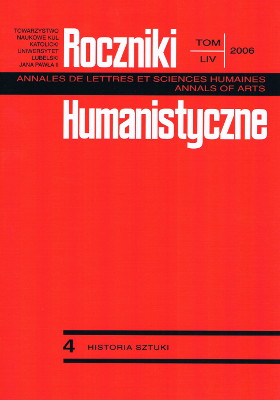The Gardens of Mary – Compositions of the Place and Plant Filler. An Outline of the Iconography of the Motif of Madonna Against the Backdrop of the Garden
Abstract
The garden as a space related and ascribed to woman has almost always been, in each culture and religion, linked with nature, and in medieval art belonged to Mary. It was identified with Madonna and ascribed to Mary, and thus became a picture equivalent of Her features. In medieval chants, hymns, and prayers Mary was compared to a garden, extolled as the most beautiful flower and the most precious rose of the garden. In painting, She became “Mary in the garden,” the Bride in hortus conclusus. The exegeses of the Song of Songs have affected the semantic and plastic dimensions of Marian gardens.
The issues connected with the formal layer allow us to notice the genesis of this motif in the Italian, Siennaean representations of Madonna dell'Umiltà painted ca. mid-14th century, and in the motif of Mary Lactans. A modest meadow in Umiltà was preceded by a decorative structure of marbles, in hortus conclusus it was transformed into a garden and was gradually enriched. The formal element, combining the two trends, aside to the motif of nature, is the stature of Mary. Madonna sitting on an ornamented pillow, lying straight on the ground, we encounter in the iconography of northern hortuses. Moreover, the semantic layer, referring to the symbols of the concept of humbleness, pictured in the stature of Mary's humility, touches the profound etymological relations, related to the meaning of the word ground – humus, the Italian term umiltà and the Latin humilitas.
In the compositional questions of Marian gardens we observe their extreme varieties and their complex development process, which does not always can be straightway derived from the Italian umiltà. The iconographic trends are separate for particular artistic milieus and they depend on geography. Therefore we cannot speak generally about Marian gardens, but about several motifs, Madonna's themes in hortus conclusus: in front of a hedge, or on a turf hedge, things we find in German or Netherlandish art, or in the rose garden house. The German names single Mary out of the rose hedge (niem. Rosenhecke) that is different from the turf hedge (niem. Rosenbank) and from the rose bower (garden house) (niem. Rosenlaube). This thematic division is condition by a kind of space in which Mary is placed. One should also take into account the semantic context that accompanies Mary and the role it plays in aconcrete representation. Therefore one may speak about the so-called elevated Umiltà, where we encounter humble Mary in the scene of coronation, about Mary as the Apocalyptic Woman, sitting in front of a turf hedge, with a half-moon at Her feet, or Mary as the earthly mother, feeding or taking care of the Baby in a home loggia with a garden at the background. In Italian art the icons of Mary against the garden, presented as the elevated Queen, the Mother of God, depict the then mores. They are connected with the liturgical dimension of holidays, the garlands with flowers and fruits, decorations we find in the later Italian tables. Another kind of iconography is presented by the images of the Woman with a unicorn.
Interpreting the icons of Mary in the garden, the complex problem how the two dimensions of the presented world interpenetrated is many times omitted; in this space only the inconographic equivalent of the mystic hortus conclusus was perceived. The symbolical layer of the garden dominated over the real, realistic surface which was particularly strongly encoded and combined by the Netherlandish artists, defined – following Panofsky – as “hidden symbolism.” In the case of the Italian artists or the Germans from the first half of the 15th century representing Madonna in the Garden we easily feel and notice the superior symbolic element, noticed against the golden background, in almost bodiless, immaterial figures, floating angels or the Persons of the Holy Trinity, popular in the Nadrenia tables, then in the Netherlandish artists the reality and symbol become concepts and transparent qualities. In Stefan Lochner's or the anonymous masters' tables from Cologne and the Rhineland, the painter of the Frankfurt Paradise Gardener the elements in which the real world existed were accumulated plants. In their species and morphological variety the earthly world was reflected, nevertheless as a complete juxtaposition of real and at the same time ideal forms, the gardens acquired an extreme and supernatural dimension. It is otherwise with the Netherlandish masters. In their wooden flower beds and ceramic pots typical plants grow, and the paintings are not specially selected. Their symbolical character has almost imperceptibly been emphasised, Mary is placed near to whiter lilies and rose ascribed to Her.
Copyright (c) 2006 Roczniki Humanistyczne

This work is licensed under a Creative Commons Attribution-NonCommercial-NoDerivatives 4.0 International License.





